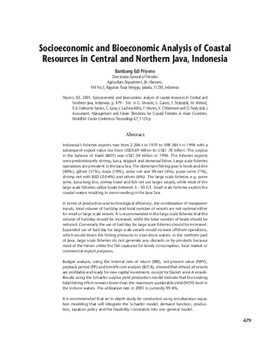Socioeconomic and bioeconomic analysis of coastal resources in central and northern Java, Indonesia

Citation
Priyono, B.E. (2003). Socioeconomic and bioeconomic analysis of coastal resources in central and northern Java, Indonesia. p. 479-516. Assessment, management and future directions for coastal fisheries in Asian countries. WorldFish Center conference proceedings; 67
Indonesia’s fisheries exports rose from 2 206 t in 1970 to 598 385 t in 1996 with a subsequent export value rise from US$0.69 billion to US$1.78 billion. The surplus in the balance of trade (BOT) was US$1.59 billion in 1996. The fisheries exports were predominantly shrimp, tuna, skipjack and demersal fishes. Large scale fisheries operations are prevalent in the Java Sea. The dominant fishing gear is hook-and-line (40%), gillnet (31%), traps (10%), seine net and lift-net (6%), purse seine (1%), shrimp net with BED (0.04%) and others (6%). The large scale fisheries e.g. purse seine, tuna long line, shrimp trawl and fish net use larger vessels, while most of the large scale fisheries utilize boats between 5 - 30 GT. Small scale fisheries exploit the coastal waters resulting in overcrowding in the Java Sea. In terms of production and technological efficiency, the combination of manpower inputs, total volume of fuel/day and total number of vessels are not optimal either for small or large scale vessels. It is recommended in the large scale fisheries that the volume of fuel/day should be increased, while the total number of boats should be reduced. Conversely the use of fuel/day for large scale fisheries should be increased. Expanded use of fuel/day for large scale vessels would increase offshore operations, which would lessen the fishing pressures in near-shore waters. In the northern part of Java, large scale fisheries do not generate any discards or by-products because most of the fishers utilize the fish captured for family consumption, local market or commercial export purposes. Budget analysis, using the internal rate of return (IRR), net present value (NPV), payback period (PP) and benefit-cost analysis (B/CA), showed that almost all vessels are profitable and ready for new capital investment, except for Danish seine A vessels. Results using the Schaefer surplus yield production model indicate that the existing total fishing effort remains lower than the maximum sustainable yield (MSY) level in the inshore waters. The utilization rate in 2001 is currently 99.4%. It is recommended that an in-depth study be conducted using simultaneous equation modeling that will integrate the Schaefer model, demand function, production, taxation policy and the feasibility constraints into one general model.
Permalink
Date Available
Type
Publisher
Countries
Copyright
CC BY 4.0
Research Themes
Topics
Language